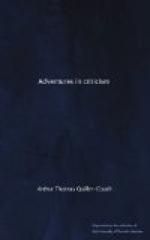The proper attitude, I should imagine, for a man “of independent mind” in these circumstances—assuming for the moment that ribands and stars are bestowed on imbeciles—would be a quiet disdain. The above stanza reminds me rather of ill-bred barking. People of assured self-respect do not call other people “birkies” and “coofs,” or “look and laugh at a’ that”—at least, not so loudly. Compare these verses of Burns with Samuel Daniel’s “Epistle to the Countess of Cumberland,” and you will find a higher manner altogether—
“He that of such a height
hath built his mind,
And reared the dwelling
of his thoughts so strong,
As neither fear nor
hope can shake the frame
Of his resolved powers;
nor all the wind
Of vanity and malice
pierce to wrong
His settled peace, or
to disturb the same;
What a fair seat hath
he, from whence he may
The boundless wastes
and wilds of men survey?
“And with how free an
eye doth he look down
Upon these lower regions
of turmoil?” ...
As a piece of thought, “A man’s a man for a’ that” unites the two defects of obviousness and inaccuracy. As for the deep feeling, I hardly see where it comes in—unless it be a feeling of wounded and blatant but militant self-esteem. As for the poetry—well, “J.B.” had rather have written it than have written one-third of Scott’s novels. Let us take him at less than his word: he would rather have written “A man’s a man for a’ that” than “Ivanhoe,” “Redgauntlet,” and “The Heart of Midlothian.”
Ma sonties!
CHARLES READE
March 10, 1894. “The Cloister and the Hearth.”
There is a venerable proposition—I never heard who invented it—that an author is finally judged by his best work. This would be comforting to authors if true: but is it true? A day or two ago I picked up on a railway bookstall a copy of Messrs. Chatto & Windus’s new sixpenny edition of The Cloister and the Hearth, and a capital edition it is. I think I must have worn out more copies of this book than of any other; but somebody robbed me of the pretty “Elzevir edition” as soon as it came out, and so I have only just read Mr. Walter Besant’s Introduction, which the publishers have considerately reprinted and thrown in with one of the cheapest sixpennyworths that ever came from the press. Good wine needs no bush, and the bush which Mr. Besant hangs out is a very small one. But one sentence at least has challenged attention.
“I do not say that the whole of life, as it was at the end of the fourteenth century, may be found in the Cloister and the Hearth; but I do say that there is portrayed so vigorous, lifelike, and truthful a picture of a time long gone by, and differing, in almost every particular from our own, that the world has never seen its like. To me it is a picture of the past more




